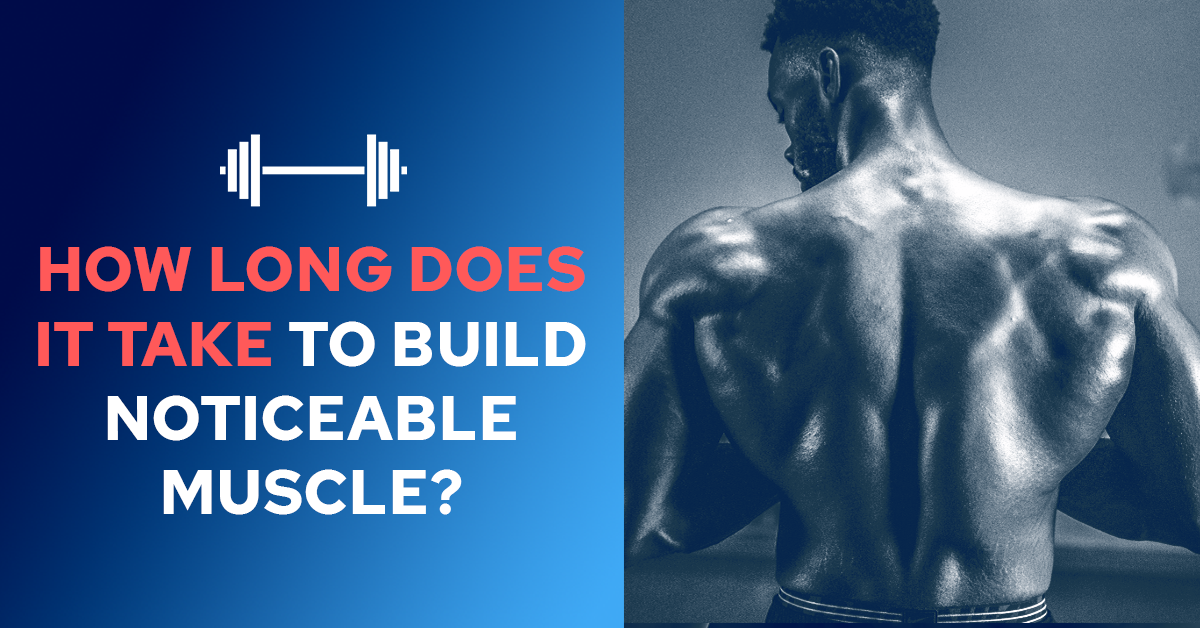How Long Does It Take to Build Noticeable Muscle: The Workout Timeline

Building muscle takes time and many people wonder how long. Research shows it takes 6-7 weeks with intense workouts to see changes. This blog will guide you through the timeline for gaining muscle, from start to finish.
Let’s get started!
Key Takeaways
- It takes 6 – 7 weeks of intense workouts to start seeing muscle changes. Regular strength training and recovery are crucial.
- Key factors for muscle growth include consistent exercise, the right diet with plenty of protein, and enough rest.
- Misleading signs like soreness or the post-workout “pump” don’t always mean muscles are growing. Real growth is shown by weight gain, tighter clothes, increased strength, visible muscle definition, and changes in body composition.
- To speed up muscle growth: maintain workout consistency with heavy lifting exercises two to four times a week, eat sufficient proteins daily from various sources, and ensure full-body recovery with adequate sleep and rest days.
- Building visible muscle requires patience; results can appear after around 10 sessions but more noticeable changes take months of dedicated effort including tailored nutrition and structured exercise plans.
The Process of Building Muscle

Muscles grow from strength training and recovery. You lift weights or do resistance exercises. Your muscles get tiny tears. Then, they heal stronger than before. This cycle is how you gain muscle mass.
It’s called muscle hypertrophy. Research says it takes 6-7 weeks of regular high-intensity training to see changes.
Eating the right foods helps a lot too. Your body uses proteins from your diet to fix the torn fibers in your muscles, making them bigger and stronger over time. Adequate sleep is also key for growth and repair.
With enough rest, you’re ready for more exercise without hurting yourself.
Next, let’s look at what can speed up or slow down this process.
Factors Influencing Muscle Growth

Three main things affect how muscles get bigger: working out regularly, eating right, and resting enough. Keep up with your exercise plan, make sure you’re getting the nutrients your body needs, and rest to see your muscles grow.
Consistent Exercise Regimen

Sticking to a workout plan is key for building muscle. You need to lift weights regularly to see results. Aim for 2-4 sessions of resistance training every week. This kind of exercise makes your muscles work hard and grow stronger.
Eating right and getting enough rest also play big roles in muscle growth. But, without a steady routine of lifting or pushing heavy objects, you won’t get the gains you’re looking for.
Keep your workouts challenging by adding more weight or doing more reps as you get stronger over time.
Proper Diet

After setting up a consistent exercise routine, paying attention to what you eat becomes crucial. For muscle building, your body needs plenty of protein and enough calories. Aim for 1.6–2.2 grams of protein per kilogram of body weight each day.
This helps repair and build your muscles after workouts. Foods like chicken breast, eggs, and milk are great sources.
Eating more food than usual is also important but in a careful way to stop fat gain. A small surplus of calories gives your body the fuel it needs to grow stronger muscles without adding unwanted fat.
Keep track of what you eat by maybe writing it down or using an app designed for health tracking. This ensures you’re getting enough nutrients and energy for muscle growth without overdoing it.
Adequate Rest and Recovery

Just as a balanced diet powers your workouts, good rest supports muscle repair and growth. Getting 7-9 hours of sleep each night is key. This downtime helps your muscles heal from the strain of lifting weights or doing high-intensity activities.
Your body repairs itself while you snooze, making this an essential part of any strength training program.
Rest days also matter a lot. They prevent overtraining syndrome, which can slow down your progress or even injure you. These breaks give your muscles time to recover before you hit the gym again.
Without enough rest, you won’t see the muscle gains you’re working hard for. So make sure to include quality sleep and recovery days in your routine for best results in building noticeable muscle.
Misleading Signs of Muscle Growth

Some signs like muscle aches, fast strength gains, and muscles looking bigger right after you work out can trick you. These don’t always mean your muscles are growing in the way you want them to.
Keep going to learn how these can mislead you.
Muscle Soreness
Feeling sore after a workout might make you think your muscles are growing. This isn’t always true. Muscle pain happens when we push our bodies harder or in different ways than they’re used to.
It’s a sign that your body is getting used to new physical activities, not necessarily that your muscles are bigger.
Getting enough sleep and taking rest days help your muscles recover from this soreness faster. Quality sleep each night falls between seven to nine hours. During this time, your body repairs itself, which is key for muscle growth but doesn’t directly relate to the soreness you feel right after exercise.
Early Strength Gains

Moving from the topic of muscle soreness, let’s talk about early strength gains. In the first few weeks of a new weight training program, you might feel stronger. This isn’t because your muscles got bigger.
Your brain and muscles are working better together. Improved neuromuscular activation happens pretty quickly, within two months of starting a regular exercise routine.
These early changes in strength come from your nervous system adapting to lifting weights or doing resistance exercises like squats and bench presses. You’re not building more muscle fibers yet; instead, your body is learning how to use what it has more efficiently.
This means even before you see big muscles, you’re getting stronger because your coordination and muscle control are improving.
Post-workout Muscle “Pump”

Just as early strength gains can trick you into thinking you’re building muscle fast, the post-workout “pump” might lead you astray. This pump is just your muscles swelling with more blood and fluid after a workout.
It feels great and makes your muscles look bigger for a little while but doesn’t mean you’ve built lasting muscle.
The truth is, this pump comes from fluids collecting in your muscles, not from true muscle growth. Many beginners focus too much on this feeling and think they’re making big gains.
In reality, building real muscle mass takes more time and consistent effort. The post-exercise pump should never be your main goal if long-term muscle growth is what you’re after.
How to Accelerate Muscle Growth
To speed up muscle growth, focus on lifting weights regularly and eating the right foods. Exercises like squats and push-ups help, along with consuming enough meat or plant-based proteins.
Exercise Consistency and Frequency

Hitting the gym two to four times every week is key for muscle growth. This routine gives your muscles the challenge they need to grow stronger. Make sure each session involves heavy lifting or pushing your muscles hard with exercises like bench presses, squats, and deadlifts.
These moves make you stronger and build muscle over time.
Keep workouts spread out through the week to give muscles time to recover. Muscle growth starts after about 10 training sessions, but sticking with it brings better results. Using free weights and doing bodyweight activities are great ways too.
This regular practice helps increase mass and improve physique steadily.
Full Range of Motion Exercises

Full range of motion exercises are key for muscle growth. They make each move stretch and work the muscle fully. This means your body uses more energy and builds more muscle. Such moves include squats, push-ups, and pull-ups.
Doing these can help you see better gains from your workouts.
Using heavy loads is important too. Lifting heavier weights during these exercises challenges your muscles more. This helps in increasing muscle size faster over time. Make sure to lift safely and increase weight gradually to avoid injuries.
Adequate Protein Intake
Eating enough protein is key for fixing and growing muscle. You need to eat more protein every day, not just on days you exercise. This helps your muscles repair after workouts and grow bigger over time.
Good sources of protein include chicken, fish, beans, and whey shakes.
You should also spread out your protein intake during the day. It’s better to have some with every meal rather than eating a lot at once. This way, your body has a steady supply of amino acids it needs to build muscle mass.
Try adding eggs for breakfast, a tuna salad for lunch, and grilled salmon for dinner to meet your daily needs.
Signs You’re Building Muscle

When you gain weight but it’s not from fat, you’re likely adding muscle. Clothes start to fit differently, especially around muscles like biceps and thighs, showing progress.
Weight Gain

Gaining weight is often a sign you’re building muscle. As you lift weights and follow a good workout plan, your body adds lean muscle mass. This makes the scale numbers go up. Resistance training at high intensity is one reason for this increase.
It’s part of how your body responds to lifting heavy objects and doing strength workouts.
To manage this weight gain well, eating right and following an effective training program are key. Beginners especially may notice they’re heavier as their bodies start to change with more muscle growth.
This kind of weight gain shows that your efforts in health and fitness activities are paying off, giving you more strength and better body composition over time.
Changes in Clothing Fit

After you start gaining weight, your clothes might fit differently. Your shirts and pants may feel tighter around the muscles you’re working out, like your arms, chest, or legs. This is a good sign that muscle is replacing fat because muscle takes up less space than fat for the same amount of weight.
You might notice this change especially in areas where you’re focusing your training regimen.
You may need to shop for new clothes if your old ones become too snug in certain parts of your body. For example, jeans could get tight around the thigh area if you’ve been doing lots of leg exercises such as squats and lunges.
Similarly, tops might feel smaller across the shoulders and chest from bench presses or push-ups. These changes show that your consistent strength training is paying off by increasing muscle mass in targeted muscle groups.
Increased Strength

You’ll notice you’re stronger as your muscles grow. Lifting heavier weights feels easier. This shows muscle-building efforts are paying off. Stick to progressive overload for best results.
Your body handles more weight with less effort over time. You can lift, push, or pull heavier items than before. This strength gain is a clear sign of muscle development. Keep challenging your muscles to see ongoing improvement.
Visible Muscle Definition
Seeing your muscles clearly is a big sign you are getting stronger. After lifting heavy things and working out often, your body starts to show more muscle. This means the shape of your arms, legs, and stomach can begin to look more defined.
It’s like when you draw lines with a pen more firmly; the shapes stand out more.
This change happens because your exercises make the muscles bigger and reduce fat in places like your waist or hip area. Eating right plays a big role too. Foods rich in protein help muscles grow after workouts.
Rest is just as important so that your body can repair itself and build those muscles up for all to see.
Changes in Body Composition
Your body starts to show changes in composition as you gain muscle. This means more muscle mass and possibly less fat. Muscle weighs more than fatty tissue, so your scale might show higher numbers.
But don’t worry, this is good weight. Your body fat percentage goes down, making muscles more visible.
You’ll also notice other signs of growing muscles like tighter fits in clothes, especially around the shoulders and thighs. These areas bulk up faster with consistent training and proper nutrition.
Strength increases too, allowing you to lift heavier weights or do more reps during workouts. All these are signs that your body is changing in the right way, thanks to your hard work at the gym and smart diet choices.
Tips for Faster Muscle Growth

For faster muscle growth, make sure to eat enough food and protein. Include exercises that target specific body parts, take rest days seriously, and stay patient with your progress.
Consuming Enough Calories and Protein
Eating the right amount of calories and protein is key for muscle growth. Your body uses calories as energy to fuel your workouts and recover afterwards. Protein helps repair and build muscle fibers damaged during exercise.
You should aim for a daily intake that supports your fitness goals.
To find out how much protein you need, try using 0.7 to 1 gram per pound of body weight as a guide. Foods rich in protein like chicken, fish, beans, and nuts are great choices. For those looking to boost their calorie count, whole grains, healthy fats from avocados or olive oil, and smoothies can help.
This approach ensures your muscles have what they need to grow stronger over time.
Targeted Training
After you’ve got your diet in check, the next step is targeted training. This type focuses on specific muscle groups with exercises that aim to build them up. Using weights that are 75% of your one-rep max proves most effective for growth.
Adjusting this load and how many times you lift it can push muscles to grow bigger.
Exercise physiologist Bianca Grover suggests changing up these factors often to keep muscles challenged. Targeted training also includes choosing activities that stress different parts of a muscle or various muscles in one go.
For instance, some workouts might focus more on the arms, while others target the legs or abs directly. This method ensures all areas get attention and can develop uniformly.
Rest Days
Rest days are key for muscle growth. Your body needs time to repair and build stronger tissues after workouts. Experts say sleeping 7-9 hours each night helps muscles grow best. Also, skipping rest can lead to injuries and slow down your progress.
Including rest in your routine makes you stronger and prevents burnout. Mark them on your calendar just like workout days. This planned break lets your body recover fully, making you ready for the next exercise session.
Patience
Building muscle takes time and patience is key. You can’t rush this process. It usually starts after around 10 resistance training sessions. For beginners, visible changes in muscle mass show up in the first few months of training.
This timeline varies for everyone based on different factors like diet, exercise consistency, and genetics.
Staying patient helps you avoid shortcuts that might harm your body or delay your progress. Shortcuts like skipping rest days or overtraining can lead to injury and burnout. Remember, gaining muscle is a slow journey that requires commitment to regular workouts, eating right, and getting enough sleep.
Keep pushing forward with patience, knowing each workout gets you closer to your goal.
Conclusion
Building muscle takes time and hard work. If you lift weights, eat right, and rest well, you might see changes in a few weeks. Keep at it for 6-7 weeks with high-intensity training to really notice a difference.
Stay consistent with your exercises and get enough protein. Then, watch as your muscles start to show!
FAQs
1. How long does it take to see muscle growth?
It takes about four weeks of consistent workouts, hitting the weights at least twice per week, for you to start seeing muscle growth.
2. Can I build muscle without gaining fat?
Yes, with a balanced diet and focusing on increasing muscle mass through strength and conditioning exercises, you can put on muscle without gaining much fat in the process.
3. What role does protein play in building muscle?
Protein is crucial for muscle protein synthesis, which helps repair and build your muscles after exercising. Eating enough protein from sources like whey protein powder supports this process.
4. Do I need a personal trainer to increase my muscle mass?
While not necessary, a personal trainer can guide you on the best ways to use weight lifting and high-intensity training effectively for hypertrophy training and increasing your overall body strength.
5. How often should I work out if I want to build noticeable muscle?
For best results, aim for workouts involving heavy weights and compound movements about 8 to 12 times over six weeks with consistency being key; remember progressive overloads are essential.
6. Are supplements necessary when trying to gain more muscles?
Supplements like creatine monohydrate or branched-chain amino acids (BCAAs) can aid in your fitness journey but aren’t strictly necessary; focus primarily on nutrition from food and regular physical activity.
















